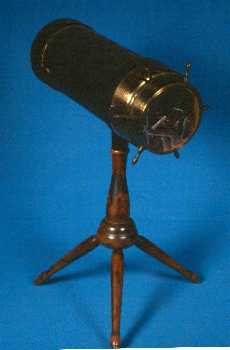
In 1819 Brewster wrote A Treatise on the Kaleidoscope, an exhaustive account that also included information on mirror configurations other than the usual three-sided, equiangular arrangement.
 |
| The kaleidoscope at the left is in the Garland Collection
of Classical Physics Apparatus at Vanderbilt University. The apparatus
has only two mirrors, unlike the usual three, and the mirrors can be set
at various angles by means of setting circles.
It was made by the firm of Jules Duboscq of Paris, and
probably purchased ca. 1875. In the 1885 Duboscq catalogue a simple, Brewster-type
kaleidoscope is listed at 15 francs ($3.00).
|